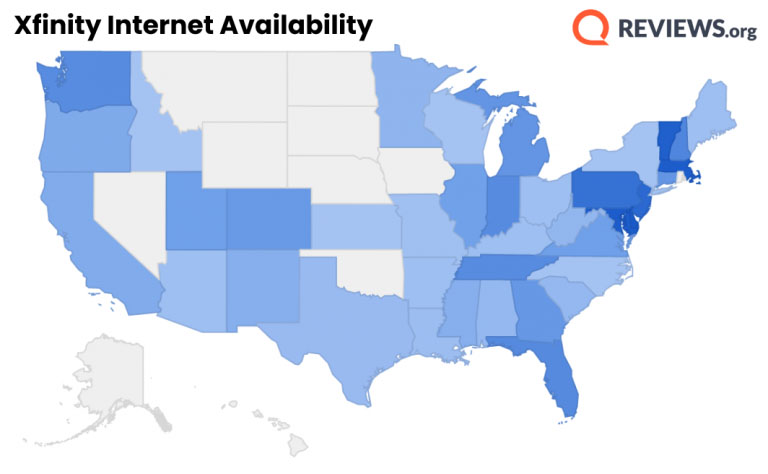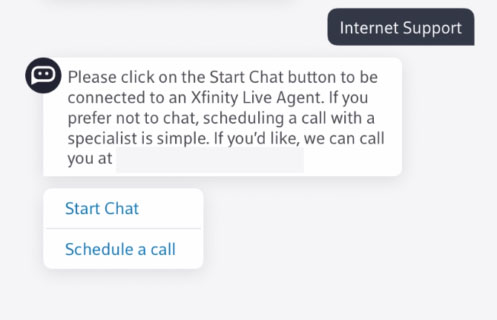Depending on where you live in the US, you’ll be looking at $20–$80 per month for your Xfinity internet bill. We’ve used Xfinity for going on 10 years now, and even though it gets a bad rap for its customer service, we still think it’s a pretty good deal. Xfinity breaks down its pricing and plan names by three different regions in the US: Northeast, Central, and West. So if you live in the Bay Area of California, your Xfinity promotional prices will be different than someone who lives in Jacksonville, Florida. Let’s take a look at how those Xfinity internet prices change from region to region. Otherwise, the Fast plan stands out as a better deal for couples and families. It gets you up to 400 Mbps speeds and costs about $50 a month—not much more than the Connect More plan, and you get a decent bump in bandwidth. Larger households may want to check out the Superfast or Gigabit plans instead. These two plans go up to 800 Mbps or 1000 Mbps respectively. That’s enough internet juice to run a home business, and the promo price for both plans is a bargain. On the other hand, AT&T’s Internet 100 plan is a DSL and fiber hybrid connection, which should boost speeds. The AT&T Internet 100 plan also comes with unlimited data, as does the Spectrum Internet® plan. (Xfinity’s plans all have a 1.2 TB data cap.) Not to mention neither AT&T nor Spectrum requires a contract, while Xfinity often does. That means Xfinity takes the cake when compared to AT&T Fiber’s Internet 1,000 plan: Xfinity’s Gigabit 1000 Mbps plan is priced too well to pass up. And the Spectrum Internet® Gig plan pushes the budget limits a bit too much, even with unlimited data and no contracts. Our only hesitation is that Windstream offers unlimited data on all of its internet plans, and AT&T offers unlimited data on its Internet 100 plan. But sadly, Xfinity still enforces a data cap of 1.2 TB. Windstream’s Kinetic Gig is by far the best deal (where promotional pricing is considered). Of course, you’ll get an extra 200 Mbps with Xfinity’s Gigabit plan, which might make it the better deal if you need that extra oomph for running a home business or Plex server. But if you prefer to go without a contract, CenturyLink may be the better deal despite its higher price. CenturyLink doesn’t bump up your bill year after year, and it comes without a contract too. The only downside? CenturyLink is a DSL connection, which tends to be less reliable and may suffer from slower speeds compared to Xfinity’s cable connection. As for Xfinity Gigabit plan prices in the West, we’d say it’s on the expensive side—Cox’s Gigablast plan is just a few dollars more per month. CenturyLink’s gig plan is pretty limited in availability, but if you can get it we say it might just be a better deal than the Xfinity Gigabit plan. Our advice? Look to the Xfinity Superfast and Ultrafast plans for a better deal and speeds that almost reach a gig.
Compared to AT&T: Versus AT&T’s DSL internet plans, Xfinity is a clear winner. But AT&T Fiber one-ups Xfinity with a low price, unlimited data, and no contracts. Compared to CenturyLink: CenturyLink’s unlimited data and lack of contracts might sway some folks, but its slow DSL speeds and high prices make Xfinity a better choice if you’re concerned about internet speed and cost. (Though CenturyLink’s fiber internet might make up some ground.) Compared to Frontier: If it’s a toss-up between Frontier DSL internet and Xfinity, go with Xfinity. Otherwise, Frontier’s Fiber Gig internet might be a better choice thanks to newer technology, unlimited data, and similar prices. Compared to Spectrum: If you’re more concerned about no contracts and unlimited data, Spectrum’s slightly higher prices might still be a better deal. But the sky-high cost of its gig plan makes the Xfinity Gigabit plan a much better choice.
If you’re still not sure whether to choose Xfinity over another internet provider, these other reviews might help.
Xfinity vs. AT&T Xfinity vs. CenturyLink Xfinity vs. Frontier Xfinity vs. Verizon Fios Home Internet
Depending on where you live, here’s a quick glance at some of the download and upload speeds Xfinity offers: Now, don’t get us wrong. Anything around 10 Mbps or faster upload speeds is probably enough to get those YouTube videos uploaded or handle a Zoom call from your boss. But anyone running a livestream or sending out large files on a regular basis might want more. Still, you can see that Xfinity scored almost 10 points better than the other ISPs. And while Frontier, Spectrum, and AT&T all scored fairly close, CenturyLink finished this race far behind the others. But if data is a concern for you, Frontier and Spectrum both offer unlimited data on all their plans. AT&T also offers unlimited data on some of its plans, and while Verizon is quiet about its true data cap, we bet it’s unlimited too.
Comcast Xfinity data cap: 1.2 TB
If your data usage is blasting past that data cap, you do have a few options for adding data to your Xfinity plan. But be warned, extra data costs extra money. If you don’t go over your data limit that often, this may be the least expensive option for you. But if you go through data like we go through a bag of white cheddar popcorn, you’ll want to look at Options 2 and 3. Or, if you’re a new customer in Xfinity’s West region, you can currently add xFi Complete for only $15 a month for a year. Just remember that will revert to the regular rate of $25 after those twelve months. If paying more for extra data makes you turn up your nose (hey, we have the same reaction), check out our YouTube guide on how to budget data for various online activities. You can also upgrade your xFi Gateway rental to include xFi Complete, which includes unlimited data and an xFi pod if you need extra coverage in your house.
Xfinity xFi Gateway rental fee: $15/month xFi Complete with xFi Gateway rental: $25/month xFi Pod Wi-Fi extender cost: $119 for one, $199 for two
But bringing your own equipment to the table tends to cost less than a full year of renting the xFi. We’ve got recommendations for Xfinity-compatible modems and routers if you prefer to bring your own equipment.
Professional installation: $100, but your pro install price might change based on where you live. And in some cases, Xfinity may not offer pro installation, so you’ll need to grab a self-install kit instead. Self-installation kit: $15, and it ships within 3–5 business days. You may still need to pay the shipping and handling fees. You can also choose to have its shipment delayed by up to 25 days if you’re in the middle of a move. Early termination fees: There’s a 30-day “money-back guarantee” period to cancel after signing up for a 12-month Xfinity plan. After that, you can expect to pay a fee for the remaining months of your service contract. Xfinity doesn’t list exact amounts, but you can expect to at least pay the monthly price for the time remaining on your contract.
Xfinity online chat Facebook: @Xfinity Twitter: @ComcastCares Comcast Internet Essentials phone number: 1-855-846-8376
And however you do get a hold of Xfinity, these customer service tips might give you a leg up. We’ve also got a guide to Comcast Xfinity customer service—so if you have TV, home security, or mobile questions, take a peek before you call. On the downside, we wish Xfinity would just swap to more affordable unlimited data already. And we’d love to see it improve its customer service even more.
Prices and plans: Xfinity’s promotional prices tend to be a good deal for the speeds you get. But there are a few better deals out there from other ISPs at a lower cost that also offer unlimited data and no contracts. Speed: Xfinity scored extremely well in our fastest ISPs report, so we’re confident you’ll get the internet speed you paid for (at least most of the time). Contracts, equipment, and fees: Most Xfinity plans require a 1- or 2-year contract. A few plans come with no contract, but they tend to cost more. The xFi Gateway modem-router combo is a good piece of equipment too. (We use it currently.) Customer service: Xfinity could improve its customer service, but then, so could most every ISP. (Not that that makes it any better.)
Connect: $19.99/month*, up to 75 Mbps download speeds, 1.2 TB data cap Connect More: $39.99/month*, up to 200 Mbps download speeds, 1.2 TB data cap Fast: $49.99/month*, up to 400 Mbps download speeds, 1.2 TB data cap Superfast: $59.99/month*, up to 800 Mbps download speeds, 1.2 TB data cap Ultrafast: $69.99/month*, up to 1000 Mbps download speeds, 1.2 TB data cap Gigabit: $79.99/month*, 1,200 Mbps download speeds, 1.2 TB data cap
If you prefer to bring your own modem, you’ll need to make sure it’s a cable modem. And we’ve got Xfinity cable modem recommendations right here if you need help shopping. Those speeds should cover you no matter how hectic a battle you get into. Want to see how other ISPs compare when it comes to MMOs or FPS games? Check out our Best Internet for Gaming review. But aside from cable TV, Xfinity’s other home services might be a bust. Here’s what our fellow experts had to say about other Xfinity services: Xfinity cable TV: “Xfinity might have a lot of fees, but at least you won’t be disappointed by Xfinity’s service. This cable TV company is reliable, widely available, and you’ll get most, if not all, of the channels you and your family want.” —Chantel Buchi, TV and streaming expert Xfinity Home security system: “Xfinity Home’s prices are hard to pin down, most of the equipment lags behind other brands, and its customer service (through Comcast) may be the worst we’ve ever encountered.” —Brianne Sandorf, home security expert Xfinity Mobile: “A solid, cheap [option] for those already in the Xfinity universe, though you have to deal with data throttling, slowdowns, and poor video streaming quality.” —Easton Smith, mobile expert This is a huge boon if you’re on vacation and can’t find a Starbucks to siphon wireless internet off of. Not to mention access to all those Wi-Fi hotspots is a lifesaver if your home internet goes down and you’ve got an assignment due the next morning. You can access the wireless hotspots through the Xfinity Wi-Fi app on your mobile device, which uses your Xfinity username and password. Xfinity has one of the largest Wi-Fi hotspot networks thanks to its xFi Gateway modems. Most of these modems are automatically set to broadcast a Wi-Fi signal. If you’re not keen on your own modem broadcasting a Wi-Fi signal that almost anyone can use, here’s how to turn off Xfinity Wi-Fi sharing. Comcast also offers a low-cost internet plan called Internet Essentials, which costs $9.95 a month for 50 Mbps speeds. Families with students may qualify for this plan if someone in your household is enrolled in a program like the National School Lunch Program.
You or someone in your household is enrolled in housing assistance, Medicaid, SNAP, the National School Lunch Program, or othersYou haven’t had Xfinity internet within the last 90 days
P.S. If you owe money on a past Xfinity internet bill, you may still qualify.
Your router is an unideal spot. Make sure your signal isn’t obstructed and that whichever device/s you use most is near the router.Make sure your internet plan is fast enough to support all connected devices using WiFi at once. If you realize that 100 Mbps isn’t going to cut it for the five family members in your home, we might suggest upgrading. If none of these are the case, try rebooting your equipment.




